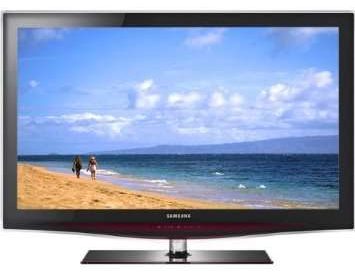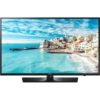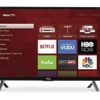Samsung LN40B630 40-Inch 1080p 120 Hz LCD HDTV with Red Touch of Color
- 40-inch LCD HDTV with full HD 1080p resolution for the sharpest picture possible and red Touch of Color design
- Auto Motion Plus 120Hz for amazingly fluid motion, 80,000:1 dynamic contrast ratio, 4ms response time, Wide Color Enhancer 3 for more vivid colors
- InfoLink RSS feeds of news, weather and sports via Ethernet; ; side-mounted USB port for displaying JPEG/MPEG files and listening to MP3 audio
- Inputs: 4 HDMI-CEC, 2 component, 2 composite, 1 PC, 2 USB, 1 Ethernet, 1 optical digital audio output
- Includes removable stand; measures 39.2 x 27.8 x 10.3 inches with stand
With Samsung’s LN40B630, you’re connected to great HD entertainment and up-to-the-minute online info. Enjoy a Full HD feast for the eyes, courtesy of the 1080p resolution and 40-inch LCD screen. Check sports scores, stock quotes, weather and other update able RSS content at just the touch of a button on your remote, with the InfoLink(tm) feature. Samsung’s Auto Motion Plus(tm)120Hz technology keeps even the fastest on-screen motion smooth and natural. Enjoy bold black tones with an impressive 80,000:1 dynamic contrast ratio. Four HDMI inputs give you fast and easy connection options for your Blu-ray Disc(r)player and gaming system. And the stylish yet subtle Touch of Color(tm) design adds a red accent to the bezel’s border perfect in any modern home.
* Widescreen aspect ratio * 80,000:1 dynamic contrast ratio * Built-in digital tuner * Fast 4ms response time * Picture-in-Picture * Game Mode * Single User Interface * Crystal Swivel Stand * Watts per channel: 10W x
Rating:  (out of 116 reviews)
(out of 116 reviews)
List Price: $ 1,199.00
Price:
Related Samsung 40-inch Products














Comments
4 comments
Rich Vergo
September 18, 2010
Review by Rich Vergo for Samsung LN40B630 40-Inch 1080p 120 Hz LCD HDTV with Red Touch of Color
Rating:
Being the first to review the 2009 Samsung LN40B630 on Amazon was purely an accident in that I actually bought the new Sony KDL-40V5100 on April 2nd. At that time, the Samsung B650 had just come out, but its high gloss panel would not have performed well in my brightly lit room. My high definition projection TV had kicked the bucket after 8-years, but I rarely enjoyed watching HD because the daylight glare would wash out the picture. The Sony’s non-glare screen performed well except when the picture would black out during dark movie scenes. I discovered that many of the V5100 series have had this glitch and Sony had no fix for it at that time. To Best Buy’s credit, they cheerfully exchanged the Sony under their 30-day return policy and delivered the Samsung B630 model which has a non-glare screen and is similar to the popular B650.
My expectations of the new Samsung were that it would perform much like the Sony. I could not have been more wrong. The B630 was like viewing another huge leap in a television experience, while the Sony seemed to be of past technology. The depth and breadth of Samsung’s visual color tones are astounding and mesmerizing. A perfect example of that came from viewing scenes of the Caribbean Sea. The Sony could not match the Samsung’s Wide Color Enhancer 3 processor with its three dimensional qualities and vibrant tones of turquoise, sea green, cobalt blue, coral pink and white sand clearly seen under the sea. It literally was like being there.
The Samsung’s dynamic contrast of 80,000-1 was visibly superior to the Sony’s 50,000-1 and convinced me that Samsung’s contrast rating was more than a marketing numbers game. The viewing angle of the Sony was horrific when moving away from center by seeing flesh tones morph into green. Samsung’s viewing angle was far better by maintaining the proper color tones, but it did lose contrast and brightness. Of course, a slight turn of its swivel base helped to alleviate Samsung’s viewing angle issue.
The downside to Samsung’s advanced technology was that every movie appeared as video and lost its magical cinema quality. Sony was superior in dealing with this issue. To address that problem, the backlight and contrast settings have to be toned down to soften the picture and to preserve a film’s attributes. Most importantly, an adjustment to the 120 Hz Motion Plus feature must be done in order to keep movies from appearing surreal. While some recommend turning the 120 Hz off, I found video blurring far too annoying and placed the Auto Motion Plus to a custom setting of 6 for blur and judder reduction. That seemed like a good compromise without losing much of the film’s realistic movement. Experiment with every adjustment to find your best settings and calibration instructions are easily found on […]. It all came together beautifully for me and hopefully this information can be helpful to you.
One bad design feature was the power and channel functions on the TV itself. You cannot see where they are unless you have light shining directly on them. As long as you use only the remote control, it may be a non-issue. By-the-way, in case you were wondering how effective the non-glare screen was on the Samsung B630; it was perfect. I experienced crystal clear high definition TV — Day or Night.
S. Gibb
September 18, 2010
Review by S. Gibb for Samsung LN40B630 40-Inch 1080p 120 Hz LCD HDTV with Red Touch of Color
Rating:
I recently purchased this item locally but am so impressed by the TV that I felt I should post my impression for others trying to decide where to spend their hard earned money, especially these days.
First, I would recommend that you to your local electronics store and look around and see which sets grab your attention as what is best to my eyes may not work for you. In my case I was somewhat limited in selection since the TV must fit into a TV cabinet that we own, so 40″ was my absolute max. This criteria limited me to Sony, Samsung, and Vizio (in order of price point). A local warehouse club had the Vizio and a comparable Samsung (ln40b610 vs. ln40b630) for side by side comparison, and simply put there was no comparison what-so-ever. The Samsung wins hands down in terms of picture clarity, overall brightness, and contrast. The 80,000:1 contrast on this TV really shines. The Samsung to Sony comparison was a bit tighter as both units offered incredible picture quality and features but again the contrast ratio on the Samsung just made everything appear more pleasing to my eye. Given this, we purchased the Samsung and haven’t looked back. Every time my wife and I watch a Blu-ray movie we are even more impressed with the picture quality! Seriously, this is a great TV at any price. The only TV I looked at that had better contrast was the Samsung LED (3,000,000:1) model but the price difference was just too much to justify.
I do have to agree with other reviewers regarding the “Auto Motion” settings producing images that are almost surreal. I have found that setting this on the middle setting produces the best results for me, but I have not played much with the custom adjustment mode yet, so I will hold off on a final review until I have had more time to tweak.
Sue
September 18, 2010
Review by Sue for Samsung LN40B630 40-Inch 1080p 120 Hz LCD HDTV with Red Touch of Color
Rating:
Delivery was great. Arrived on time and set up the TV for me.
I couln’t get the HDMI ports to work. Had the cable company come. They tried three HD boxes and two HDMI cables. Said the problem was the TV.
I called Samsung. They arranged for a new board to be shipped and arranged a repair time. The repair person had the same problem after he replaced the board. No HDMI ports worked. Said that they would have to send a new main board. After the next board was installed, they decided that the TV was not repairable. They gave me a number to call at Samsung to arrange a replacement.
Samsung did not have the same TV available. They said I could get a lesser model in exchange. If I want at least all the options I had before I would have to pay an additional $198.00. This is ridiculous.
Ryan Mcmahon
September 18, 2010
Review by Ryan Mcmahon for Samsung LN40B630 40-Inch 1080p 120 Hz LCD HDTV with Red Touch of Color
Rating:
I couldn’t decide between a plasma and an LCD, so I bought both (with the intention of returning one) and set them up side by side, my cable hookup going to both. The plasma was a Panasonic TC-P42S1, the LCD was a Samsung LN40B630. I did my comparison channel-by-channel with lots of different programming, ranging from talk shows to cartoons to action movies to football games, in both high def and standard def.
Both are very good 40-42 inch TVs, in my opinion. Once I had adjusted the settings to my liking, I was hard-pressed to say that one looked notably better or worse than the other, though each had its strengths and weaknesses.
The Panasonic plasma had slightly more vibrant colors than the Samsung LCD. Blacks were noticably blacker and dark blues and purples looked deeper. The off-angle viewing was fantastic on the plasma, too. With the LCD, a smidge of color was lost when you shifted from 0 to 45 degrees. From deeper side angles, the picture was still watchable, but definitely shifted towards gray.
However, the Samsung LCD had a brighter, crisper image. In a dark room, details stood out better, and any programming that wasn’t dark looked a little sharper. During the day, with the sun shining in, the LCD’s image held up a bit better, too.
Motion is supposedly better on plasmas, but I couldn’t really tell when comparing to a 120Hz LCD. Both TVs did equally well with typical television, and what blurs I saw seemed to be in the source material. I watched a football game for a while, but if the plasma gave a better viewing experience, it wasn’t terribly obvious to me. Then again, I’m not a big sports fan, so maybe my eye isn’t discerning enough. (Update: see below)
Color accuracy seemed great on both TVs, but the Panasonic needed some adjusting to get there. The picture is too green with the default settings.
Both TVs did a near-equal job with standard def programming (aside from the differences above).
Sound: adequate on both. I have a surround-sound system, so I didn’t really care.
Hardware failures: I’ve read complaints about both brands — seems like it’s a roll of the dice either way. I went with a 4 year warranty.
Other stuff: the Samsung had a better remote, a nicer menu system, and more fine adjustments available. I also like the swivel stand and the fact it’s a lot lighter than the Panasonic. I didn’t try the internet features on either TV.
Overall, both are very good TVs, and all but the most picky videophiles would be happy with either. In 2009, both plasma and LCD have come a long way and which technology is “better” really boils down to your wallet, viewing conditions, and personal preference. It was a tough choice for me, but, in the end, the bright, crisp picture of the Samsung won out. I can live with marginally less vibrant colors, weaker blacks, and imperfect off-angle viewing (if I watch from the other room, I’ll swivel the screen).
*** UPDATE ***
Turns out the Samsung has a demo mode that lets you split the screen and see one half with de-blur processing turned on and one half with it off. I did a little testing by hooking up my laptop and scrolling images and text around. Without the processing, there is a noticeable blur on high-contrast moving objects, though it wasn’t significant enough to really bother me. _WITH_ the processing, moving text was more crisp, but there seemed to be a slight delay, which I imagine would make this mode unusable for serious videogamers. People who are highly sensitive to motion blurring might prefer a plasma.
Write a Reply or Comment: